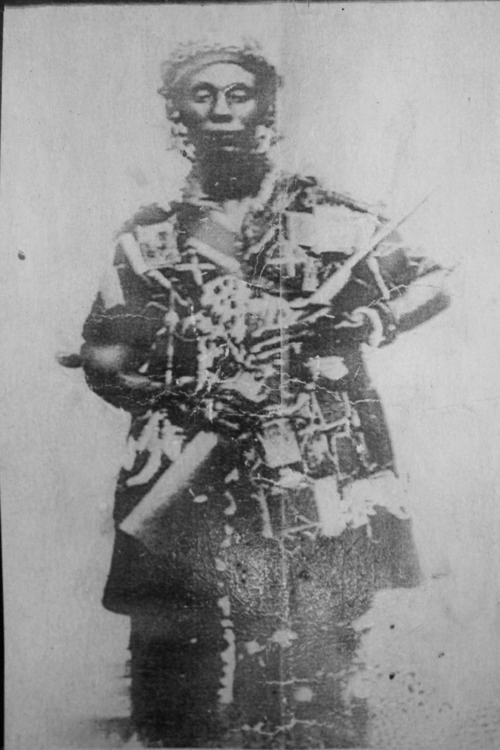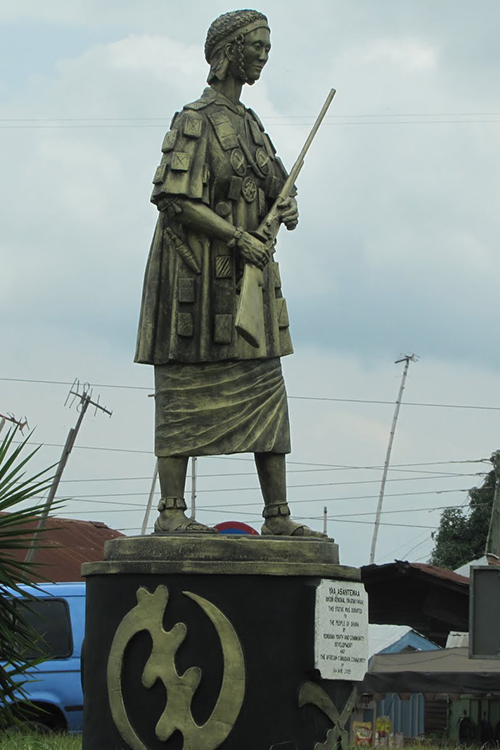After Prempeh I exile to Seychelles, the period 1900 Yaa Asantewaa led the Ashanti rebellion known as the War of the Golden Stool against British colonialism. This war, is one that the Asante people and of course the whole of Ghana always narrate with pride. It’s been used to empower women and to tell new generations of how courageous our ancestors were at the time when the British invaded Ghana.
During their reign, Yaa Asantewaa saw the Asante Kingdom go through a series of events that threatened its future, including civil war from 1883 to 1888. When her brother died in 1894, Yaa Asantewaa used her right as Queen Mother to nominate her own grandson as Ejisuhene.
When the British exiled the Ejisuhene to the Seychelles in 1896, along with the King of the Asante, Prempeh I and other members of the Asante government, Yaa Asantewaa became regent of the Ejisu-Juaben District.
After the deportation of Prempeh I, the British governor-general of the Gold Coast, Frederick Hodgson, demanded the Golden Stool, the symbol of the Asante nation. This disrespectful request led to a secret meeting of the remaining members of the Asante government at Kumasi, to discuss how to secure the return of their king. There was a disagreement on how to bring them back and also some of them were reluctant to carry on fighting the British. Yaa Asantewaa, who was present at this meeting, stood up and addressed the members of the council with these famous words: “Now I see that some of you fear to go forward to fight for our king. If it were in the brave days of Osei Tutu, Okomfo Anokye, and Opoku Ware, chiefs would not sit down to see their king to be taken away without firing a shot. No European could have dared speak to chiefs of Asante in the way the governor spoke to you this morning. Is it true that the bravery of Asante is no more? I cannot believe it. It cannot be! I must say this: if you, the men of Asante, will not go forward, then we will. We, the women, will. I shall call upon my fellow women. We will fight the white men. We will fight till the last of us falls in the battlefields.
With this, she took on the leadership of the Ashanti Uprising in 1900, gaining the support of some of the other Asante nobility.
Hence, it was Yaa Asantewaa who rallied resistance in defence of the ‘golden stool’, the sacred symbol of unity of the Asante people. The British garrison was besieged and its occupants fled back to the coast.
Beginning in March 1900, the rebellion laid siege to the fort at Kumasi where the British had sought refuge. The fort still stands today as the Kumasi Fort and Military Museum.
After several months, the Gold Coast governor eventually sent a force of 1,400 to quell the rebellion. Re-enforced from their colonies all over Africa, the British large and well equipped army was sent to capture Yaa Asantewaa.
Her spirit was not to be broken, she fought and retreated again and again with her ever diminishing band of supporters until, more than a year later Queen Yaa Asantewaa and 15 of her closest advisers were captured, and they too were sent into exile to the Seychelles, where she died.
The rebellion represented the final war in the Anglo-Asante series of wars that lasted throughout the 19th Century. On January 1, 1902, the British were finally able to accomplish what the Asante army had denied them for almost a century, and the Asante Empire was made a protectorate of the British crown. Yaa Asantewaa died in exile on October 17, 1921. Three years after her death, on December 27, 1924, Prempeh I and the other remaining members of the exiled Asante court were allowed to return to Asante. Prempeh I made sure that the remains of Yaa Asantewaa and the other exiled Asantes were returned for a proper royal burial. Yaa Asantewaa’s dream for an Asante free of British rule was realized on March 6, 1957, when the Asante protectorate gained independence as part of Ghana, the first African nation to achieve this feat.
Yaa Asantewaa remains a much-loved figure in Asante’s history and the history of Ghana as a whole for the courage she showed in confronting injustice during the colonialism of the British.
To highlight the importance of encouraging more female leaders in Ghanaian society, the Yaa Asantewaa Girls’ Secondary School was established at Kumasi in 1959 with funds from the Ghana Educational Trust and it is now one of the leading and popular Secondary School in Ghana.
In 2000, week-long centenary celebrations were held in Ghana to acknowledge Yaa Asantewaa’s accomplishments. As part of these celebrations, a museum was dedicated to her at Kwaso in the Ejisu-Juaben District on August 3, 2000. Unfortunately, a fire there on July 23, 2004, destroyed several historical items including her sandals and battle dress seen in the photograph above. The current Queen-mother of Ejisu is Yaa Asantewaa II. A second Yaa Asantewaa festival was held August 1–5, 2006, in Ejisu.
To this day, Yaa Asantewaa is still a very much-loved person in Ghana. Her un-bowing pride and courage in the defence of her country remained an inspiration to the people of Ghana.
Source: Wiki/Asanteman Association, USA



